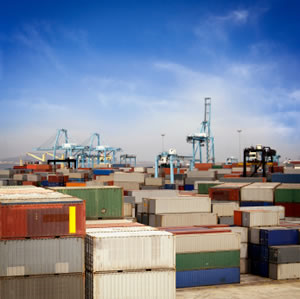Managing Global Supply Chains
Countless high-quality products that enrich our lives are made in and sourced from China every day. Chinese exports range from the lowest-tech toys to the highest-technology computer electronics. Yet for every successful sourcing experience in China, there is more than one disappointment or complete failure. So, the question is, “Why are some companies so successful at managing supply chains in China, while others are not?”
The answer is rooted in the fact that successful supply chain management in China depends on very different principles and practices than in the West. Companies that don’t understand and adjust to those differences invite problems. To help supply chain managers recognize and understand how to adapt to those differences, this article offers a four-point formula for successful supply chain management in this dynamic country, which will inevitably play a critical role in future global trade.
Decoding the differences
At the most fundamental level, China’s commercial environment is still young; China has been deeply engaged in Western-like commerce for little more than two decades. The principles that Western businesspeople take for granted are not ingrained throughout Chinese business yet. Some simple “rules,” such as not substituting materials in customer-specified products without prior customer approval, don’t have the same intuitive acceptance in China as in the West. Companies that try to manage suppliers without understanding this and the many other differences they will encounter almost inevitably experience disappointment. Decoding the differences, however, is not an insurmountable challenge, but it takes patience, curiosity, and a disciplined approach to supply chain management.
Suppliers as capable as the best in the West can be found in China. At the same time, suppliers that would not be able to find a single customer in the West because of their substandard quality, delivery, and support performance can still survive in some segments of China’s market. How can this paradox coexist in today’s global and increasingly transparent marketplace? In the West, the absolute quality difference between excellent and poor suppliers is actually small. The broad pursuit of continuous improvement throughout the supply chain drives acceptable quality standards forward, and the competitive environment has eliminated suppliers that don’t keep pace.
This is not the case in China, however. Figure 1 conceptually depicts the basic difference between the quality profiles of the developed Western and evolving China supply chain environments. Excellent suppliers exist in both worlds. The average quality level in the West is higher, and no poor-quality suppliers can survive. In China, the continuing demand from the state-owned industrial segment, where quality standards are often (but not always) lower than Western norms, provides Chinese suppliers with a market for lower-quality products that does not exist in the Western world. The challenge for Western companies seeking suppliers in China is to connect with suppliers that are aligned with Western quality and performance expectations. Chasing low prices exclusively is almost never the right approach to assure compliance with a Western company’s quality needs.
Four keys to supply chain success
Based on decades of experience working in China and guiding Western businesses as they establish and manage supply chains there, China Centric Associates has identified four keys to success in supply chain management:
- Execute an effective supplier-qualification process.
- Before placing the first order, assure synchronization of understanding with suppliers of all aspects of supplier-customer “rules of engagement.”
- Adjust your routine supply chain management processes to the differences in the China supply chain environment.
- Continually test alternative supplier options and challenge existing suppliers to improve in terms of cost, delivery, and quality.
Let’s take a look at each of these important steps.
1. Execute an effective supplier-qualification process. Effective supplier qualification in China involves more than checking product samples, equipment, and quality documentation. While these are effective, everyday tools in the West, they may not be used in the same way in China. For example, Chinese suppliers know that Western customers expect to see control charts, work instructions, and visual indicators. However, a large percentage of Chinese companies do not understand the importance of these tools in effective operational management. Statistical process-control charts are often kept and filed with no closed-loop management discipline to control operations outputs. Commonly, many of these tools remain new to Chinese suppliers, and the process of infusing them into management discipline is still a work in progress.
Instead, effective supplier qualification requires assessing the stability of a supplier’s management and processes to maximize confidence that the selected supplier can consistently meet the full range of your requirements, including those related to product, total cost of product acquisition, quality, and logistics. If the buy is a strategic, ongoing need, then the goal should be to select a dependable and long-term supply chain partner and not just chase the lowest-price product. If you search and qualify suppliers effectively, then you will almost never have to sacrifice price for quality and support performance.
It’s critical that a supplier evaluation be adjusted in both format and content to reflect the core differences in relative sophistication between the Chinese and Western supply chain environments (a topic that will be discussed further in step 3).
A disciplined supplier-qualification process also identifies strengths and weaknesses in processes that are very often the determinants of actual long-term success. Understanding a supplier’s strengths and weaknesses allows you to predict that supplier’s ability to deliver sustained product, quality, delivery, and communications performance. It is recommended that buyers apply a detailed supplier-qualification process that baselines and assesses a supplier across a wide range of measures in six functional disciplines:
- manufacturing facility and process equipment
- manufacturing management processes
- quality systems
- technical support
- logistics and export capabilities
- general management and finance
Importantly, the buyer should take nothing for granted in the supplier-qualification process, and instead verify information when possible. For example, it is important to seek out documented linkages between control charts and formal feedback and process-improvement programming in operations.
2. Synchronize expectations through contracts. The second key to China supply chain success is synchronizing the understanding of all customer-supplier “rules of engagement” from the outset. Innocent mismatches of expectations between Western customers and Chinese suppliers about Western commercial principles are extremely common. If you engage a Chinese supplier assuming its management intuitively understands how suppliers and customers interact in the West, you are taking a big risk.
For that reason, a formal supply contract that memorializes the full range of engagement rules with suppliers and minimizes the potential for innocent mismatches of expectation is a necessity. Indeed, the importance of contracts cannot be overstated. Keep in mind that from the Chinese perspective, “If it’s not in writing, it didn’t happen!” and “If it’s not in writing, it’s not important!”
Simply sending a purchase order to a Chinese supplier may work for commodity-like buys, but for any other types of products, using purchase orders alone is a risky path. The more strategic the buy, the more critical it is to assure that your Chinese supplier understands clearly all required dimensions of the supply relationship. It is recommended that for all purchases of strategically important buys, formal supply contracts that are more comprehensive than we would use in the West be established with suppliers. Contracts need to define all possible “rules of engagement,” including, but not limited to, product specifications, quality-assurance requirements, terms and conditions of sale, intellectual property considerations, custom safety-stock programs, and noncompete provisions. Investing the time to do this before any actual purchases have been made prevents problems later. In combination with disciplined supplier qualifications, a complete supply contract sets a sound foundation of transparent understanding and expectation between buyers and Chinese suppliers.
3. Refine Western supply chain management processes. The third key to success is refining your company’s routine supplier management processes to suit in China. These processes work effectively in the West, but they are almost certainly suboptimized for use in China.
In the West, buyers typically exercise “arm’s length” accountability for supply consistency and compliance across all requirements, and they expect suppliers to manage these requirements with a minimum of active intervention by the buyer. China will someday reach that same state, but its supply chain is currently far from being that developed; Western customers who adopt the same approach in China can be risking their franchises.
The following example highlights this point. A high-profile Western toy company damaged its reputation—perhaps irreparably—by mismanaging its Chinese suppliers. After over 20 years of seemingly problem-free imports of high-quality toys, this company relaxed or lost its supplier quality-assurance discipline, and suppliers began to use lead paint, which failed to meet Western consumer-safety standards. The toy company suffered financial losses and damaged its reputation with consumers, and its chief executive officer (CEO) was forced to admit publicly that the problem was not with the Chinese suppliers, but came from failures in the company’s own documentation, designs, and management processes. Similar scenarios repeat with disappointing frequency, resulting too often in painful outcomes.
This incident also highlights the fact that it is the buyer’s responsibility—not the supplier’s—to be sure that product designs meet all regulatory requirements of the market in which they will be sold. A related consideration is that Chinese suppliers’ sophistication in regard to manufacturing processes, such as quality assurance, material management, and manufacturing engineering, lags that in the West. These processes have taken generations to develop in the West, and they are still “in progress” in China.
Because of the relatively unsophisticated state of many Chinese suppliers, it is wise for any Western company sourcing there to exercise routine mentoring and monitoring of supplier performance. This means routine visits and project meetings with suppliers, performing periodic requalification audits, and implementing on-site quality-assurance programs or inspections. It may also require working on specific product- and process-improvement projects. Any supplier can get the first order right when all eyes are focused on it. It takes systemic stability of a supplier’s production and management processes to turn start-up success into long-term supply performance. If it is not practical for your company to do this directly from your home country and you don’t want to invest in having your own team in China, consider engaging an experienced third party to assist.
4. Continually test and adjust your supplier base. The fourth key to China supply chain success is to continuously test and adjust the supplier base. In the West, supply chain professionals are constantly scanning the general supply base, searching for new suppliers and options to optimize performance in a dynamic environment. It is surprising how many companies abandon this practice when sourcing from China. They often find a supplier and then stick with that supplier for years, with little or no investigation of alternatives.
Rising costs in and immediately around major cities in eastern China, such as Shanghai, Guangzhou, Shenzhen, and Beijing, present challenges for Western companies that found qualified suppliers years ago. The movement of the axis of industrial development into secondary cities further west and the rapid enhancement of both the technology base and the local workforce’s experience expands the options available in those secondary cities. Many of these cities are surprisingly advanced and inviting from industrial and commercial standpoints and in terms of their overall quality of life.
To sustain and improve supply chain performance in China requires an ongoing focus on monitoring the dynamic supply chain environment there, scanning for suppliers that can deliver improved total value. In other words, the same discipline that is exercised to continuously adjust and optimize supply chain performance in the West needs to be exercised in China as well. In fact, because China’s supply base is younger and more dynamic, with faster development and growth than that in the West, it is arguably more important.
No short cuts to success
Back to our initial question: “Why are some companies so successful managing China supply chains, while others are not?” The simplest answer is that companies that succeed in China understand that practices that work in the West need to be refined when working in China.
Supply chain success in China is no more difficult than anywhere else in the world, if the Western company sourcing there understands and follows the four key steps and the recommendations discussed in this paper. There are no short cuts to success!
Source: Supply Chain Quaterly


![[Figure 1] The China quality challenge](http://www.supplychainquarterly.com/issues/2017/04/images/figures/thumbnails/20171211managing_supply_chains_in_china_ex1.thumb.jpg)


